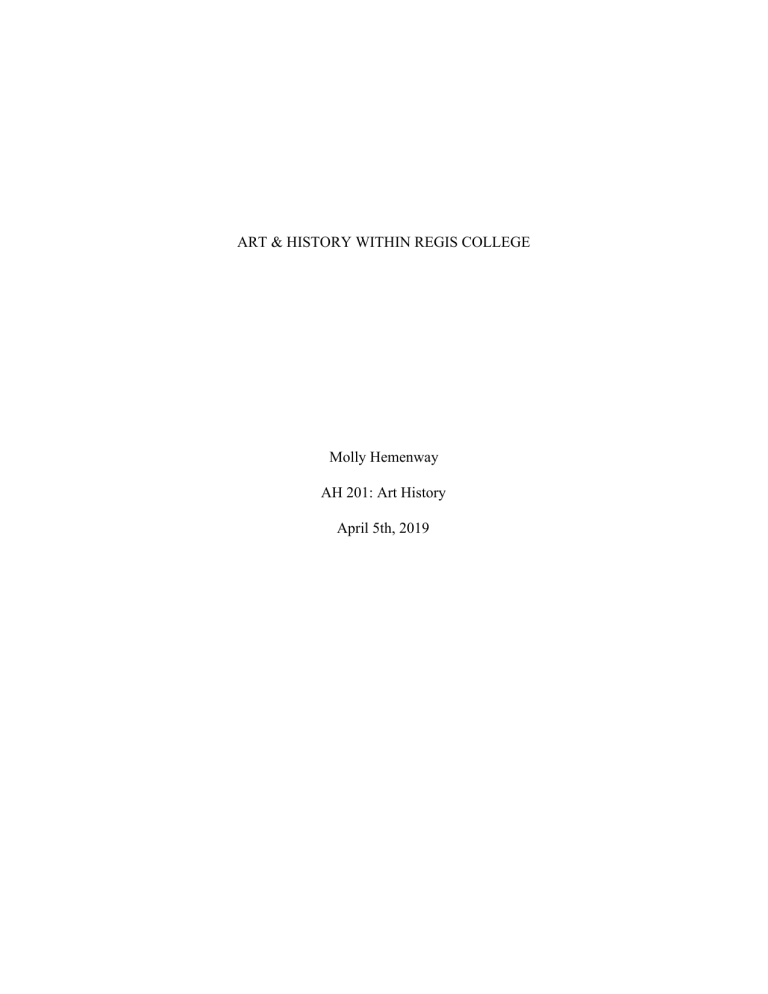
ART & HISTORY WITHIN REGIS COLLEGE Molly Hemenway AH 201: Art History April 5th, 2019 1 Art and history are essential to each other’s existence. Art is valued more with a historical value and backstory, and history is recorded in an artistic way. Art is the journal of those who lived during that time, a record of how those living felt and viewed the world around them as it was developing. Without history many of the images, architecture, statues or art of other forms would have little to no meaning. An otherwise insignificant piece can be exponentially valuable if it is signed by Monet, Leonardo or Dali simply due to their personal value in history as trend-setting men. A modern example is of the famous Jackson Pollock, known for his abstract splatter paintings that without his hand involved could be mistaken for a child’s craft. Keeping in mind that art and history go hand in hand, this essay will discuss the history and it’s artistic repercussions on the Regis College campus. The greater Boston area in general has a combination of older, historical architecture mixed with a fair share of sleek modernization in newer buildings around the city. Regis college as a micro community compared with Boston represents these attributes with architecture ranging from the 1800’s to additions built in the 2000’s. Regis is widely known as a private, Catholic institute founded by the Sisters of Saint Joseph. Their original goal was to expand opportunities for females in higher education. Based on their religious morals, they wanted to create an educational facility that would give all (despite appearance) access to knowledge and learning. On September 21, 1927 Regis opened its arms to their first ever class, but much of the architecture here was built much before then as early as 1888 ("A History of Regis College."). There are many buildings on the Regis campus, many of them oozing with artistic and historical significance. Just outside the Regis library is a white angelic statue greeting every student to walk into the facility. Another ode to the catholic nuns who founded our college lies in 2 the stone tower and sacred grounds in an off-the-path garden. This place features granite benches, a stone tower, a statue of Madonna under a miniature stone arc topped with a cross. There are even more statues, paintings and tapestries in the college church to be seen as well ("Regis College Virtual Tour."). My focus will be in breaking down the components of College Hall inside and outside and discussing how these components relate to artistic styles discussed in class. College Hall was the first new building to be brought unto the campus circa 1928. Inside was offices, class spaces, rooms for residency, and more. This made Regis college the first Catholic women’s college in Massachusetts with residential options for students. Eventually in 2007 Regis officially transitioned into a co-ed facility ("A History of Regis College."). College Hall represents much of this history behind Regis, both inside and out there are glimpses of the past. The outer structure frames the catholic roots of its founders and the inside contains relics in the form of paintings, statues and of course more architecture. The outward appearance of College Hall combines federal and religious styles, making the building appear stately and deific at the same time. A golden cross is placed atop the front 3 entrance, maybe a reference to the golden halo seen around the heads of Madonna and child, as many biblical figures painted during classical European times had. The decorative columns holding up the entryway and rooftop balcony give flashbacks to classical Greek and Roman architecture. Immediately I am drawn to their similarity to the columns on the Pantheon in Rome, Italy all with a simplistic shaft and more intricate moldings on the tops and bottoms. This is also the format seen in many federal buildings of Washington, D.C. such as the Lincoln Memorial or the White House itself. Clean white buildings with columns almost always seems to signify that the building is for the purpose of duty, wisdom and higher power. Inside there are more marble-esque columns and deep red carpeting emulating the patterns of a tapestry. Maroon red is often a hue associated with leadership, energy and goodwill. Every aspect of this building was put there meticulously to scream importance, and that it rightfully does. College Hall is a center for many ceremonies. For some it is their first impression of the campus, so to give a luxurious and opulent vibe is quite justified, and alluring to future alumni. Finally, I will address these three statues found in the College Hall atrium. Without a proper history of these sculptures, knowledge of the artist behind their making or even 4 an informational plaque to base my opinions off of I am left to assume and surmise their meanings. The basis of their creation has to have some significance to the college, therefore I predict that they are of figures that have helped shape the college and the programs offered there. As art is in the eye of the beholder, when little to no background information is given, my imagination lead me to believe these three statues are representative of the nursing and education majors on campus. The two children pose playfully in ruffled dresses which reminds me of the education major and the children’s daycare on campus. The woman is posed more seriously with a lean, hand on hip. Her vase (of water?) and rope sparked the thought of Florence Nightingale, the founder of modern nursing. Her stature of confidence, head looking straight on and her basic tools at her side symbolize the wit and knowledge of necessity nurses like her possess. Reiterating my previous statement, I cannot be sure whatsoever that these are the true, original intentions of this art but my guesses are educated and calculated as any. It is clear to see that Regis College has much deep rooted history, and much of it documented through old records and photos accessible online to anyone interested. It is fascinating to discover and interpret the architecture and other art pieces that have arisen from the foundation of such a unique place. The Sisters of Saint Joseph would be proud and appreciative to see how astonishing our campus has become while still keeping lots of our past elements as we progress into future renovations. Art and history has been and will always be an outstanding part of Regis. 5 Bibliography "A History of Regis College." Regis College. Accessed April 13, 2019. Kleiner, Fred S., and Helen Gardner. Gardners Art through the Ages: A Global History. Boston, MA, USA: Cengage Learning, 2020. "Regis College Virtual Tour." Regis College. Accessed April 13, 2019. https://www.regiscollege.edu/about-regis/find-us/virtual-tour.



